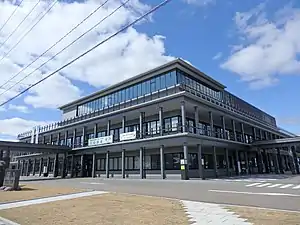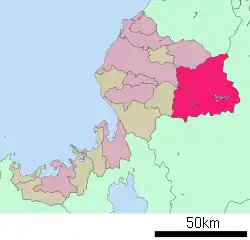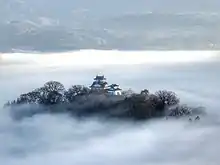Ōno, Fukui
Ōno (おおのし, Ōno-shi) is a city located in Fukui Prefecture, Japan. As of 1 July 2018, the city had an estimated population of 33,640 in 11,747 households and the population density of 39 persons per km².[1] The total area of the city was 872.43 square kilometres (336.85 sq mi). The town is encircled by a ring of mountains and the only way in or out is via tunnels or mountain roads.
Ōno
大野市 | |
|---|---|
 Ōno City Hall | |
 Flag  Seal | |
 Location of Ōno in Fukui Prefecture | |
 Ōno | |
| Coordinates: 35°58′47″N 136°29′15″E | |
| Country | Japan |
| Region | Chūbu (Hokuriku) |
| Prefecture | Fukui |
| Government | |
| • - Mayor | Shiho Ishiyama (since July 2018) |
| Area | |
| • Total | 872.43 km2 (336.85 sq mi) |
| Population (July 2018) | |
| • Total | 33,640 |
| • Density | 39/km2 (100/sq mi) |
| Time zone | UTC+9 (Japan Standard Time) |
| City symbols | |
| -Tree | Fagus crenata |
| -Flower | Magnolia kobus |
| -Bird | Cettia diphone |
| Phone number | 0779-66-1111 |
| Address | 1-1 Tenjincho, Ōno-shi, Fukui-ken 912-8666 |
| Website | www |

Geography
Ōno is located in mountainous northeastern Fukui Prefecture, bordered by Ishikawa Prefecture to the north and Gifu Prefecture to the east and south. The city is geographically the largest municipality in Fukui Prefecture, occupying one fifth of the prefecture's territory. The Kuzuryū River flows through the city. Parts of the city are within the borders of Hakusan National Park.
Climate
Ōno has a Humid climate (Köppen Cfa) characterized by warm, wet summers and cold winters with heavy snowfall. The average annual temperature in Ōno is 13.1 °C. The average annual rainfall is 2385 mm with September as the wettest month. The temperatures are highest on average in August, at around 26.0 °C, and lowest in January, at around 1.0 °C.[2]
Demographics
Per Japanese census data,[3] the population of Ōno has been in decline over the past 40 years.
| Census Year | Population |
|---|---|
| 1970 | 44,694 |
| 1980 | 43,379 |
| 1990 | 41,837 |
| 2000 | 39,632 |
| 2010 | 35,291 |
History
Ōno is part of ancient Echizen Province. During the Edo period, Ōno developed as the castle town of Ōno Domain. Following the Meiji restoration, it was organised into part of Ōno District in Fukui Prefecture. Much of the old town of Ōno was destroyed in a fire on April 8, 1888. With the establishment of the modern municipalities system on April 1, 1889. the town of Ōno was established. Ōno merged with the villages of Shimosho, Kamisho, Goka, Sakadani, Tomida, Inuigawa and Oyama and was raised to city status on July 1, 1954. Ōno annexed the neighbouring village of Nishitani on July 1, 1970. On November 7, 2005, the village of Izumi was merged into Ōno. Ōno and the surroundings were the setting for the 2011 non-fiction book For Fukui's Sake, written by a British author who resided there for two years.
Government
Ōno has a mayor-council form of government with a directly elected mayor and a unicameral city legislature of 18 members.
Economy
The economy of Ōno is mixed, with agriculture, forestry and seasonal tourism playing prominent roles.
Education
Ōno has ten public elementary schools and five middle schools operated by the city government, and two public high schools operated by the Fukui Prefectural Board of Education.
Transportation
Railway
Highway
- E67 Chubu-Jukan Expressway
 National Route 157
National Route 157 National Route 158
National Route 158 National Route 364
National Route 364 National Route 418
National Route 418 National Route 476
National Route 476
Local attractions
References
- "Official statistics of Ōno City" (in Japanese). Japan: Ōno City. Retrieved 25 May 2018.
- Ōno climate data
- Ōno population statistics
External links
 Media related to Ōno, Fukui at Wikimedia Commons
Media related to Ōno, Fukui at Wikimedia Commons- Official website (in Japanese)
 Ōno, Fukui travel guide from Wikivoyage
Ōno, Fukui travel guide from Wikivoyage